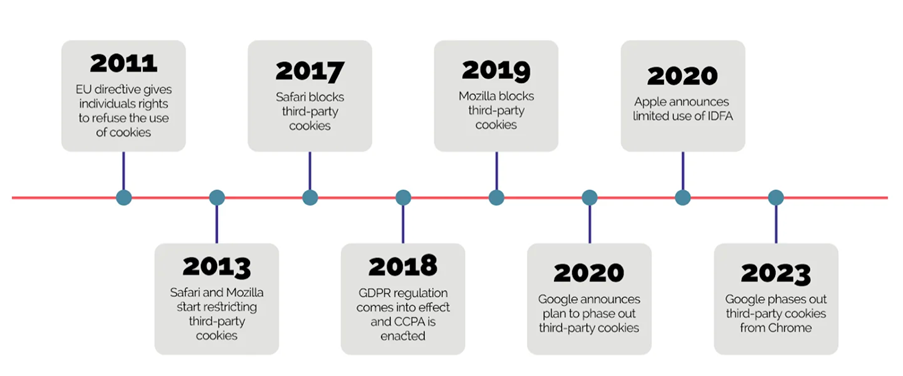
The Cookie Full Context
In the rapidly evolving landscape of digital marketing, businesses are facing a transformative shift towards cookies-less technologies. The imminent demise of third-party cookies has ushered in a new era of privacy-centric practices, challenging organizations to reevaluate their digital strategies. This paradigm shift towards a cookies-less future demands innovative approaches and a comprehensive digital transformation strategy.
Understanding the Cookie-less Landscape: Cookies have long been the backbone of online advertising, enabling targeted marketing and personalized user experiences. However, concerns about user privacy and increasing regulations, such as GDPR and CCPA, have accelerated the shift towards a cookie-less ecosystem. The rise of privacy-focused browsers and changes in major platforms’ policies underline the urgency for businesses to adapt.

Major Players already phased out or in that direction over the period. As from January 4, 2024, Google has also mentioned that third-party cookies will be removed and provide new feature called Tracking Protection.
Google originally announced a two-year delay for the phase out in 2021, but the delay was primarily to give marketers more time to adjust their advertising approach.

Challenges in Cookies-less landscape:
- Limited Targeting Precision: In a cookieless environment, traditional tracking methods are restricted. This limitation can reduce the precision of audience targeting, making it challenging for advertisers to reach specific segments with personalized messages.
- Attribution Complexity: Tracking user journeys across devices and channels becomes more complex without third-party cookies. Advertisers may face challenges in accurately attributing conversions and determining the effectiveness of their campaigns.
- Personalization Hurdles: Personalized advertising relies heavily on user data. Without detailed individual tracking, advertisers may find it more challenging to deliver hyper-personalized content and recommendations.
- Dependency on Walled Gardens: As third-party cookies decline, major platforms with walled gardens, such as Google and Facebook, gain more control over user data. Advertisers may become overly dependent on these platforms, limiting diversity and competition in the digital advertising ecosystem.
- Privacy Concerns and Regulations: Privacy is a growing concern, leading to increased regulations. Advertisers must navigate stringent privacy laws (e.g., GDPR, CCPA) and ensure compliance while delivering targeted campaigns.
Customer Data Platform is to Rescue
Customer Data Platforms (CDPs) emerge as a robust solution in the cookieless world, addressing many of the challenges advertisers face while capitalizing on the opportunities. By amalgamating data from zero, first, second, and permissible third-party origins, CDPs enable marketers to construct comprehensive user profiles.

These profiles go beyond basic demographics to include detailed information about preferences, behaviors, purchase history, engagement patterns, and more. Armed with this intricate understanding of customers, marketers can:
Nagarro addressing challenges in this Digital landscape:
- Unified Data Management:
CDPs provide a centralized hub for collecting, organizing, and activating customer data from various sources. In the absence of third-party cookies, having a unified repository of first-party data becomes even more critical for effective targeting and personalization.
- First-Party Data Utilization:
With a focus on first-party data, CDPs empower advertisers to leverage customer insights obtained directly from interactions with the brand. This reduces reliance on third-party data and enhances the quality and relevance of targeting efforts.
- Enhanced Personalization:
By consolidating customer data into comprehensive profiles, CDPs enable advertisers to deliver highly personalized experiences across channels. Advanced segmentation and audience analysis capabilities help tailor messaging and offers to individual preferences and behaviors.
- Attribution and Analytics:
CDPs facilitate cross-channel attribution and analytics, allowing advertisers to measure the impact of their campaigns and optimize marketing strategies. Despite the absence of third-party cookies, CDPs enable granular tracking and analysis of user interactions within the brand ecosystem.
How Nagarro is helping Leveraging Opportunities using CDP:
Our strong tech knowhow allows us to take the CDP game to industry specific consultancy, advance analytics and AI driven use case implementations. Our team continues to build reusable AI models which can be easily integrated to any CDP and produce astonishing results for marketeers. We are helping customer to maximize value out from customer data platform to provide highly personalized user experience and employ targeted advertising strategies.
- Consent Management:
CDPs often include consent management features, allowing advertisers to obtain and manage user consent transparently. Adherence to privacy regulations and user preferences is streamlined, fostering trust and compliance in a cookieless environment.
- Contextual and Intent-Based Targeting:
In the absence of individual tracking, contextual targeting gains prominence. CDPs enable advertisers to leverage contextual and intent-based data to place relevant ads in the right content environments, maximizing engagement without relying on cookies.
- Real-Time Personalization:
With real-time data processing capabilities, CDPs enable dynamic personalization of content and offers based on user interactions. Advertisers can respond to user behavior promptly, delivering timely and relevant messages across touchpoints.
- Agility and Adaptability:
CDP is designed to be agile and adaptable, allowing advertisers to integrate new data sources, technologies, and compliance requirements seamlessly. This flexibility enables marketers to navigate evolving privacy landscapes and emerging advertising trends effectively.
- Customer Retention and Loyalty:
By harnessing insights from CDPs, advertisers can strengthen customer retention and loyalty initiatives. Personalized communication and tailored experiences based on comprehensive customer profiles foster long-term relationships and advocacy.
Conclusion: In the cookie-less world, Customer Data Platforms emerge as a strategic solution for advertisers seeking to navigate challenges and capitalize on opportunities. By leveraging first-party data, enabling personalized targeting, ensuring compliance with privacy regulations, and fostering agility and adaptability, CDPs empower advertisers to thrive in an evolving digital advertising landscape. As the importance of privacy and data transparency grows, CDPs serve as a cornerstone for ethical and effective marketing practices.

